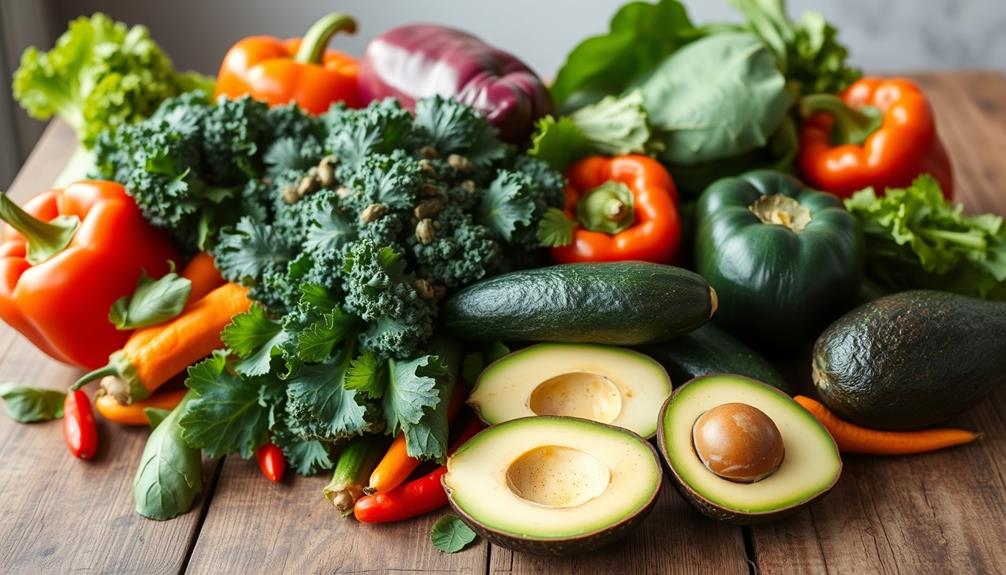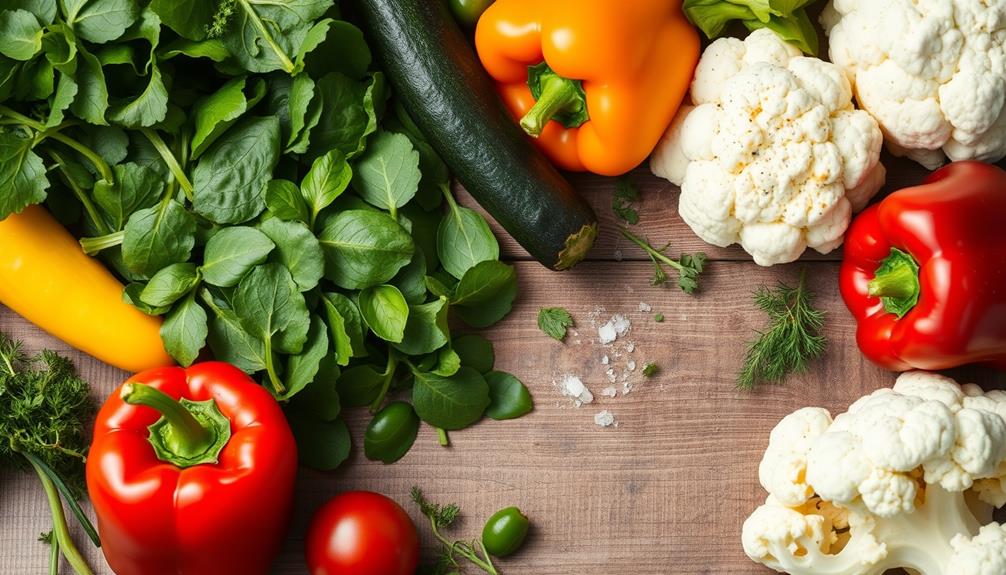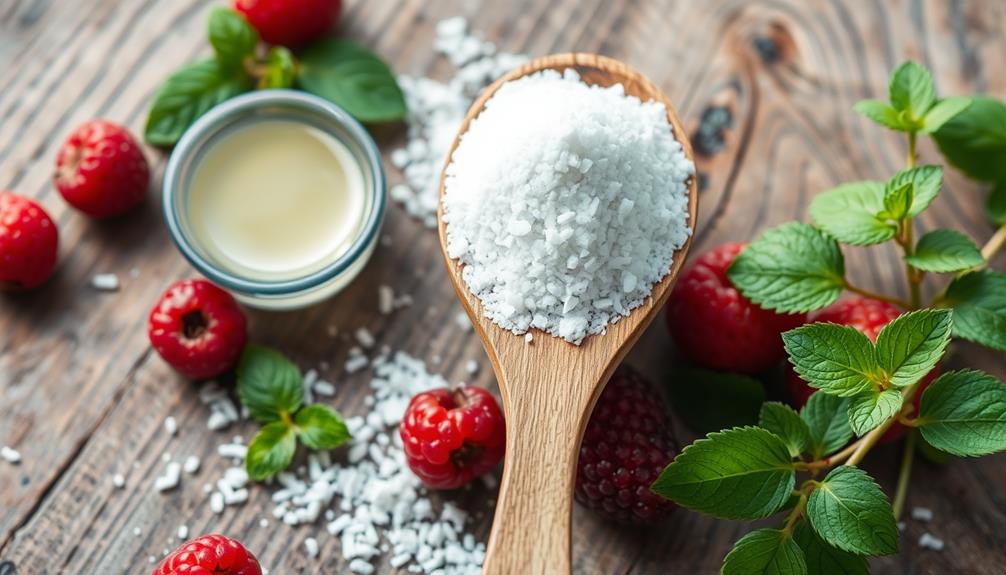For a successful keto diet, focus on low-carb vegetables. Spinach, zucchini, cauliflower, mushrooms, and asparagus are excellent choices, all ranging from 2.97 to 4 grams of net carbs per 100 grams. These vegetables provide essential nutrients while keeping your carb count low. You'll want to avoid starchy options like potatoes and sweet corn, as they can spike your carb intake. Cooking methods like roasting or grilling can enhance flavors without adding carbs. Experiment with healthy fats and seasonings to make your meals even tastier. Stick around to explore more about how these veggies can fit into your keto lifestyle!
Key Takeaways
- Spinach, zucchini, cauliflower, mushrooms, and asparagus are excellent low-carb vegetables suitable for a keto diet.
- Limit carbohydrate intake to 20-50 grams daily to maintain ketosis.
- Prioritize vegetables high in nutrients and low in starch and sugar for optimal health benefits.
- Cooking methods like roasting, grilling, and sautéing enhance flavors while keeping carb counts low.
- Avoid high-carb vegetables such as potatoes, corn, and sweet potatoes to stay within keto guidelines.
Understanding the Keto Diet

The keto diet is a powerful approach to transforming your eating habits by focusing on a high-fat, moderate-protein, and very low-carb plan. This low carb diet typically limits your carbohydrate intake to 20-50 grams per day, allowing your body to enter a state of ketosis, where it burns fat for energy.
Understanding the importance of vegetables in this regimen is essential. You'll want to prioritize low-starch and low-sugar vegetables, as they provide crucial nutrients while keeping your carb content minimal.
Incorporating vegetables like spinach, zucchini, and cauliflower into your meals can be beneficial. These veggies generally contain only 1 to 4 grams of carbs per 100 grams, making them perfect for your ketogenic lifestyle.
However, it's vital to avoid starchy vegetables like potatoes and corn, as their higher carb counts can disrupt ketosis. By selecting a variety of keto-friendly vegetables, you not only enhance your dietary diversity but also make sure you're getting important vitamins, minerals, and antioxidants, all essential for maintaining your health during this change.
Embrace these choices, and you'll find that the keto diet can be both nutritious and satisfying.
Top Low-Carb Vegetables

Choosing the right vegetables is key to successfully following a keto diet. Incorporating low-carb vegetables can help you stay within your carb limits while providing essential nutrients. Here are some of the top low-carb vegetables you should consider:
| Vegetable | Carbs (per 100g) | Nutritional Benefits |
|---|---|---|
| Spinach | 3.63g | Rich in calcium, iron, antioxidants |
| Zucchini | 3.11g | Versatile, hydrating, low-carb noodles |
| Cauliflower | 4g | Great rice and mashed potato substitute |
| Mushrooms | 3.26g | High in potassium and antioxidants |
| Asparagus | 3.88g | Nutrient-dense, vitamins A, C, E |
These vegetables not only fit perfectly into your keto diet but also bring a host of health benefits. Spinach and asparagus are nutrient-dense, while zucchini and cauliflower can be transformed into delicious low-carb dishes. Mushrooms pack a nutritional punch and are a versatile addition to any meal. By choosing these low-carb vegetables, you'll keep your meals exciting and compliant with your keto lifestyle!
Nutritional Profiles of Key Vegetables

When it comes to optimizing your keto diet, understanding the nutritional profiles of key vegetables can make a significant difference.
Spinach is a fantastic choice, containing just 3.63 grams of carbs per 100 grams. It's rich in calcium, iron, and antioxidants, making it a nutrient-dense option.
Zucchini is another excellent pick, with only 3.11 grams of carbs per 100 grams. It's high in vitamin C and versatile enough to be transformed into low-carb noodles.
Mushrooms offer 3.26 grams of carbs per 100 grams and are packed with potassium and antioxidants, contributing positively to your overall health.
Cauliflower is a superstar, containing just 4 grams of carbs per cooked cup. You can use it as a rice substitute or even make a pizza crust, adding fiber along with essential nutrients.
Finally, asparagus has 3.88 grams of carbs per 100 grams, providing a good source of iron and potassium. You can enjoy it both raw and cooked, making it a nutritious and delicious side dish.
Incorporating these low-carb vegetables into your ketogenic diet can help you achieve your health goals while keeping your meals exciting.
Cooking Tips for Keto Vegetables

When it comes to cooking keto vegetables, the right preparation techniques can make all the difference.
You'll want to try methods like steaming, roasting, or grilling to enhance flavors while keeping carbs low.
Don't forget to add healthy fats and seasonings to boost taste and nutrient absorption!
Preparation Techniques
Preparing keto-friendly vegetables can transform your meals into delicious and satisfying dishes. Try various preparation techniques to enhance flavors and preserve nutrients. Here's a quick overview of effective cooking methods:
| Preparation Technique | Description |
|---|---|
| Roasting | Toss vegetables like broccoli and Brussels sprouts in olive oil and seasonings, then bake at 425°F for 20-30 minutes. |
| Sautéing | Cook leafy greens such as spinach and kale in olive oil or butter over medium heat for 3-5 minutes until wilted. |
| Grilling | Slice zucchini and asparagus, grill over medium heat for 5-7 minutes, turning for even cooking to achieve a smoky flavor. |
| Steaming | Steam cruciferous veggies like cauliflower for 5-7 minutes, keeping them tender yet vibrant in color. |
For a revitalizing option, don't forget raw preparations! Combine arugula, cucumbers, and bell peppers to create a crunchy, low-carb salad. Drizzle with keto-friendly dressings like olive oil and vinegar to elevate your dish. These techniques not only make your vegetables tastier but also keep their nutrients intact, making your keto diet both enjoyable and healthy.
Flavor Enhancements
Enhancing the flavor of keto vegetables can elevate your meals from ordinary to extraordinary. You can transform your vegetable dishes into delicious options that fit perfectly into your meal plan. Here are some flavor enhancements to ponder:
- Use Healthy Fats: Sauté or roast your vegetables in olive oil, coconut oil, or butter. This not only boosts flavor but also incorporates healthy fats essential for the keto diet.
- Incorporate Herbs and Spices: Fresh herbs like basil and oregano or spices such as cumin and paprika add depth without increasing carbs.
- Roasting Techniques: Roast vegetables like Brussels sprouts or cauliflower at high temperatures. This caramelizes their natural sugars, intensifying flavors and making them more appealing.
- Cheese Toppings: Sprinkle grated cheese over veggies before baking or broiling. This adds richness and creaminess while keeping carb counts low—an excellent choice for cheesy zucchini or broccoli.
You can also use low-carb marinades, like a garlic and lemon vinaigrette, to further enhance the taste of your vegetables.
Vegetables to Avoid on Keto

Not all vegetables fit into a keto diet, and it is crucial to know which ones to avoid to stay within your carb limits. Consuming high carb content vegetables can disrupt ketosis and hinder your low carb intake goals. Below is a table of vegetables to avoid on keto, along with their carb counts:
| Vegetable | Carbs (per 100g) |
|---|---|
| Sweetcorn | 23.5g |
| Potatoes | 17.8g |
| Sweet Potatoes | 16.82g |
| Peas | 14.45g |
| Carrots | 9.08g |
As you can see, sweetcorn tops the list with the highest carb content, making it a top vegetable to steer clear of. Potatoes and sweet potatoes also rank high and should be removed from your plate. While peas and carrots contain fewer carbs, they should still be limited in your keto diet. By avoiding these vegetables, you'll be better equipped to maintain ketosis and achieve your dietary goals. Stay mindful of what you eat to maximize your success on the keto journey!
Additional Low-Carb Options

When you're looking for low-carb options, cauliflower stands out for its incredible versatility and nutritional benefits.
You can whip it up in various cooking techniques, from ricing to roasting, making it a perfect fit for your keto meals.
Plus, it makes for an ideal snack when prepared right, keeping your cravings in check while staying on track.
Nutritional Benefits of Cauliflower
Cauliflower stands out as a stellar choice for anyone following a keto diet, packing just 4 grams of carbohydrates per cooked cup. This versatile vegetable isn't just low-carb; it also offers a host of nutritional benefits that can support your overall health.
Here are some key benefits of incorporating cauliflower into your meals:
- Rich in Vitamins: Cauliflower is an excellent source of vitamins C and K, which support immune function and bone health.
- Promotes Digestive Health: Its high fiber content aids in digestion and contributes to effective weight management.
- Antioxidant Properties: Cauliflower helps combat oxidative stress, potentially reducing the risk of chronic diseases.
- Low-Carb Substitute: You can easily use cauliflower as a substitute for rice or mashed potatoes, keeping your meals low-carb and satisfying.
Versatile Cooking Techniques
Exploring versatile cooking techniques can make your keto journey both enjoyable and delicious. You can easily incorporate low-carb vegetables into your meals with a few clever methods.
For instance, spiralizing zucchini creates a fantastic pasta alternative, perfect for your favorite spaghetti dishes or fresh salads.
Another great option is cauliflower rice. By grating or processing cauliflower into rice-sized pieces, you can enjoy a low-carb substitute in stir-fries or grain bowls without sacrificing flavor.
Roasting vegetables like asparagus and Brussels sprouts enhances their natural sweetness, making them a delectable side dish that fits perfectly into your keto diet. Just toss them in olive oil and your favorite seasonings before popping them in the oven.
You can also get creative with stuffed peppers. Hollow out bell peppers and fill them with high-fat ingredients like cheese or meats for a satisfying meal that adheres to keto guidelines.
Lastly, grilling asparagus imparts a smoky flavor while preserving its nutrients, making it an ideal low-carb side for barbecues or meal prep.
These techniques won't only diversify your meals but also keep your keto diet exciting and flavorful.
Ideal Snack Choices
Looking for ideal snack choices on a keto diet? You'll want snacks that are low in carbs and packed with healthy nutrients. Here are some excellent choices for people looking to maintain their diet:
- Celery: At just 2.97 grams of carbs per 100 grams, it's hydrating and crunchy.
- Cucumbers: With 3.63 grams of carbs per 100 grams, they're invigorating and also help prevent dehydration.
- Radishes: Offering only 3.4 grams of carbs per 100 grams, they're a great option for adding crunch to your salads or eating raw.
- Zucchini: At 3.11 grams of carbs per 100 grams, spiralize it into noodles or grill it for a satisfying snack.
These vegetables contain low carbs per serving, making them fit for the keto lifestyle.
Plus, mushrooms at 3.26 grams of carbs per 100 grams can be used in various dishes or enjoyed on their own.
Incorporating these snacks into your routine won't only satisfy your cravings but also provide your body with essential nutrients.
Make these ideal snack choices part of your keto journey!
Health Benefits of Keto Vegetables

When it comes to following a keto diet, incorporating the right vegetables can greatly enhance your health. Keto vegetables are low in carbohydrates, making them perfect for maintaining ketosis and supporting weight loss. For instance, spinach has just 1g of net carbs per half-cup cooked, allowing you to enjoy its health benefits without worrying about carb intake.
Many keto-friendly vegetables, like broccoli and Brussels sprouts, are high in fiber, which promotes digestive health and helps you feel fuller longer. Nutrient-dense options such as asparagus and zucchini provide essential vitamins and minerals, including vitamin C and potassium, while remaining low in calories.
Moreover, the antioxidants found in tomatoes and mushrooms may combat oxidative stress, reducing the risk of chronic diseases. By consuming a variety of keto vegetables, you not only boost your immune function but also guarantee you're getting a well-rounded intake of essential nutrients, like calcium in celery and iron in spinach.
Frequently Asked Questions
What Are the Best Keto Vegetables to Eat?
When choosing keto vegetables, focus on low-carb options. Spinach, zucchini, cauliflower, asparagus, and mushrooms are great choices. They're nutrient-dense, versatile, and can easily fit into your meals while keeping your carb intake low. These vegetables also provide essential vitamins and minerals, making them some of the best ketofriendly vitamins. For example, spinach is rich in iron and calcium, while cauliflower is a good source of vitamin C. By incorporating these low-carb veggies into your diet, you can ensure you’re getting the necessary nutrients while following a ketogenic eating plan.
What Are the Top 5 Keto Foods?
So, you're on a quest for the top five keto foods? How original! Try avocados, eggs, cheese, nuts, and fatty fish. They'll keep you satisfied while you pretend bread never existed. Enjoy your delicious low-carb adventure!
What Is the Lowest Carb Vegetable?
When you're looking for the lowest carb vegetable, spinach stands out with just 1 gram of net carbs per cooked half-cup. It's versatile and perfect for adding to your meals without packing on carbs.
What Vegetables Are Not Keto?
You should avoid vegetables like sweetcorn, potatoes, sweet potatoes, green peas, and even carrots on a keto diet. Their high carb content can hinder your progress and disrupt your ketosis. Keep your choices low-carb!
Conclusion
Incorporating the right vegetables into your keto diet can transform your meals and boost your health. As you savor the crunch of fresh spinach or the vibrant flavor of zucchini, you might just find yourself reconnecting with the joy of eating. It's funny how a simple choice can lead to such satisfaction and well-being. Embrace these low-carb veggies, and you'll not only nourish your body but also rediscover the pleasure of wholesome, delicious food.









